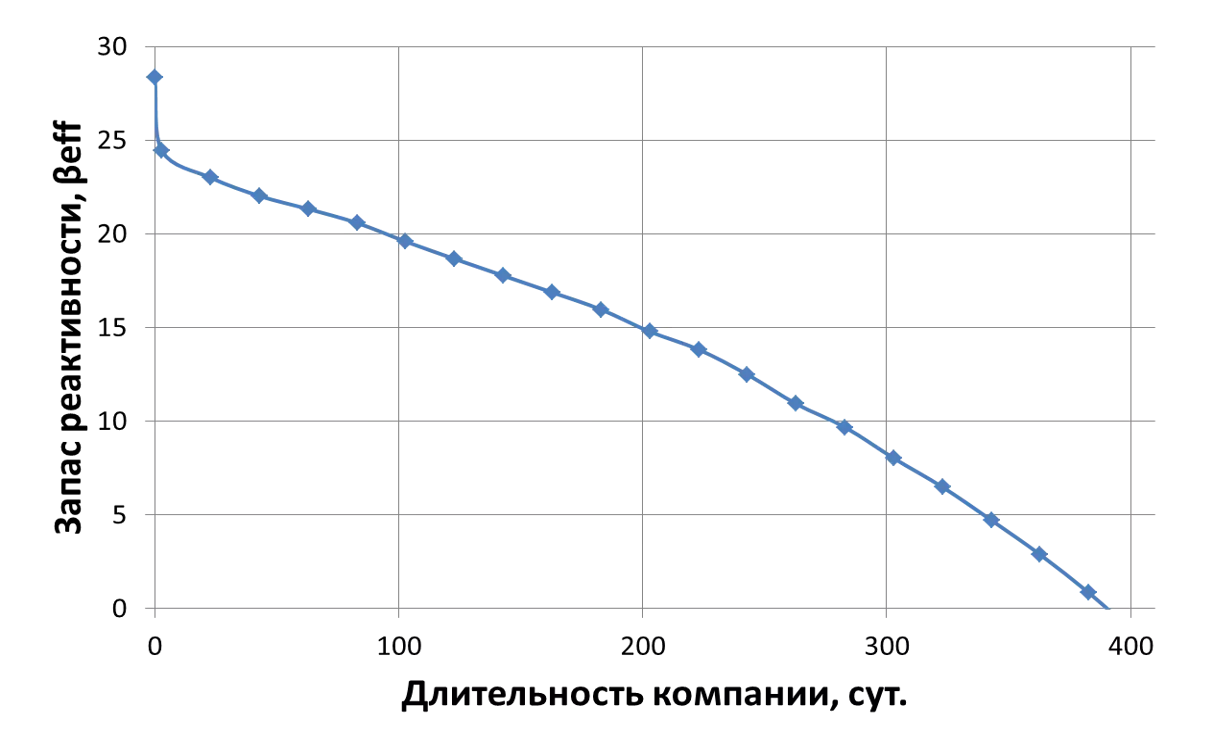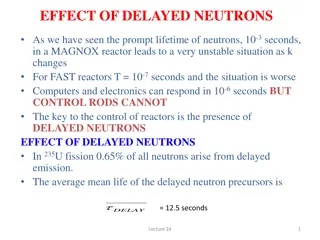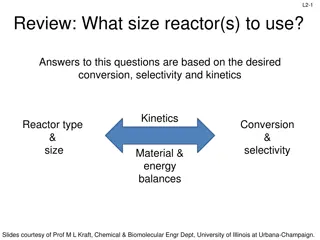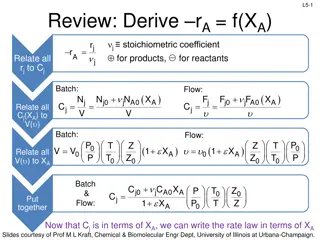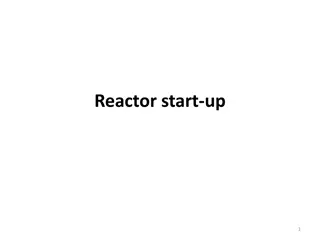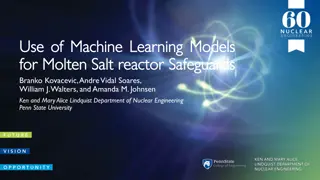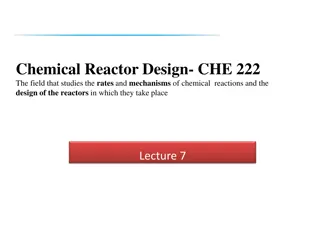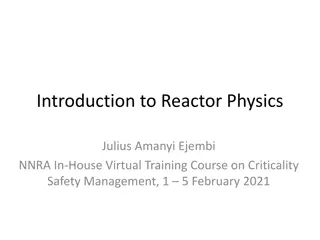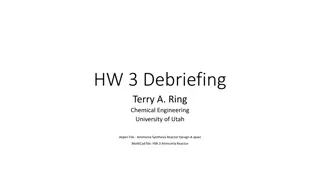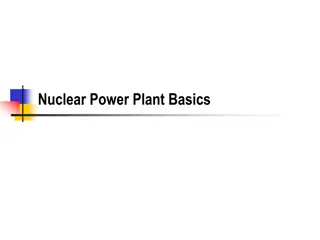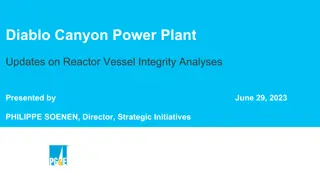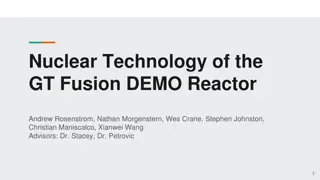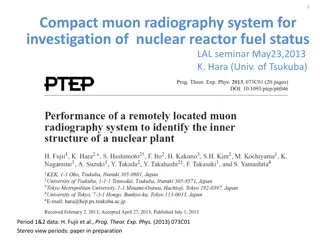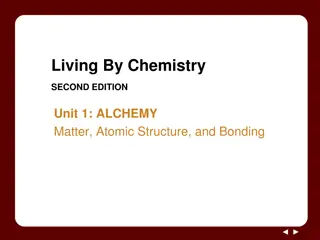Understanding Reactor Campaign in Nuclear Power Operations
Reactor campaign in nuclear power operations is crucial for ensuring safe and efficient reactor power operation. It involves managing reactivity margin, fuel residence time, nominal power, and effective days of operation. Reactor campaigns are influenced by various factors such as fuel elements' resistance, accumulation of fission products, and power levels during operation. This article provides insights into the key aspects of reactor campaigns in nuclear reactors.
Download Presentation

Please find below an Image/Link to download the presentation.
The content on the website is provided AS IS for your information and personal use only. It may not be sold, licensed, or shared on other websites without obtaining consent from the author. Download presentation by click this link. If you encounter any issues during the download, it is possible that the publisher has removed the file from their server.
E N D
Presentation Transcript
Reactor campaign Reactor campaign ( nr) -- period of the reactor power operation from one total refueling to another. 1
Reactor power operation is accompanied by various effects which cause loss of reactivity or its change. Therefore, to compensate these effects, the core at the beginning of the operation in cold, not poisoned state should have a certain initial reactivity margin mardue to additional fuel load. The value mardefines reactor campaign. 2
hange reactivity margin during the reactor campaign Working hours, day
Reactor campaign is also determined by operating capacity (resistance) of the fuel elements, which largely depends on the accumulation of fission products. The accumulation of fission products is determined by the permissible burnup fraction and is a characteristic value for a particular type of reactor. For VVER it is about 3 5%. 4
Reactor campaign (nr) - period of the reactor power operation from one total refueling to another. Fuel campaign ( f) is a fuel residence time in the nuclear reactor core in terms of Wnomduring a complete cycle taking into account the n partial refuelings up to obtaining maximum burnup fraction: f= n nr Each unloaded portion of fuel is in a nuclear reactor n time intervals nr between refuellings. 5
Nominal power of a nuclear reactor -- is the highest power at which it can operate in all modes provided for the campaign. 6
Reactor campaign is measured in the effective days (hours) eff. When reactor power operates at various power levels Wi Wnomduring icalendar days (hours), reactor campaign in effective days is recalculated by energy production in the reactor: Qk= Wi i= Wnom eff, 7
Energy production of a nuclear reactor -- total amount of thermal energy produced during the reporting calendar period of nuclear reactor operation. Potential opportunities for energy production are characterized by energy store and energy source. 8
Energy content of the nuclear reactor core - energy production from the beginning of its operation until the exhaustion of marwhen operating at Wnom. Energy resource of the nuclear reactor core - energy production from the beginning of its operation at Wnomuntil the appearance of fatal defects of the core in which its further use is impossible. 9
mar is usually provided Some increase of for guaranteed supplying of calculation energy resources. Calendar operation time of nuclear reactor core up to the production of energy resource is called service life. 10
Fleet average unit capability factor (FAUCF). Reactor campaign can also be expressed via calendar residence time of fuel in the reactor iand fleet average unit capability factor during this time (load factor). 11
Fleet average unit capability factor (FAUCF) of a nuclear reactor is the ratio of the average reactor power in the reporting period of time, to the nominal: FAUCF = Wav/ Wnom= (1/ Wnom)( Wi i/ i). FAUCF is used for quantitative assessment of reactor use intensity. 12
When the nuclear reactor operates, heating of the core is caused by: the transfer of kinetic energy of the fission fragments to the surrounding atoms and molecules of the medium, moderation and neutron radiative capture in all components of the core, absorption of instant -radiation and and -radiation of the fission fragments and their decay products. 14
Distribution of energy released in nuclear fission of 235U by a thermal neutron 15
The table doesn't consider the contribution of neutrinos accompanying -decay of fission fragments, although the energy carried away by them reaches 10 MeV. This is because neutrinos do not interact with any substances and, therefore, do not cause heating of the reactor elements. Very low additional energy from -decay and delayed neutrons were neglected. 16
Kinetic energy of the fragments and - particles is converted into thermal in the immediate vicinity of the fission points. All antineutrino energy and part of neutron energy and -quanta are carried away by them outside the nuclear reactor core. This is partly compensated by the energy released in neutron radiative capture ( 7MeV). 17
The relative contribution of different energy carriers, as well as the total fission energy Ef , generated as a result of one fission event, depends essentially on the properties of used fissile nuclide (235U, 233U or 239Pu), energy spectrum of neutrons and absorbing properties of reactor materials. 18
The spread of values depending on these characteristics, can reach 7%. That is why, in practical calculations one usually takes that, on average, per one fission event energy is released f= 203 = 0,32 10-10J. 19
Using these data, by known: - average density of thermal neutron flux in nuclear fuel av, neutron/(cm2 s) - volume of fuel - multiplication factor by fast neutrons ( ), - macroscopic fission cross section 235U f5, (cm-1) we can estimate thermal power, (W), of a nuclear reactor, V, (cm3) 20
thermal power (W), of a nuclear reactor, is proportional to the amount of nuclear fission in fuel in the reactor core per unit time: W = 0,32 10-10 avV f5 21
Reactor power, defined by this expression, is an integral characteristic of the heat release in the nuclear reactor core. To evaluate heat-stressed cores, one cannot use reactor power , the introduction of special specific characteristics is required. 22
Important characteristics of the energy-rating of a nuclear reactor are: specific fuel power, i.e. reactor power per mass unit of uranium in the core, WGu= W / Gu= 0.32 10-10 avV f5 / Gu, where Gu mass of uranium loaded into the core, (kg); 23
specific power per mass unit of fissile material in the core, (for VVER 235U), WG5= = W / G5= 0.32 10-10 avV f5 / G5, where G5- mass of 235U loaded into the core, kg; specific volume power (volumetric heat release density), i.e. power per unit of the core Wv= W / V = 0.32 10-10 av f5 24
Unevenness of energy release ( kv, kr, kz ) A reactor always has unevenness of energy release due to various reasons. Since thermophysical reactor calculation is carried out for a maximum load, it is necessary to establish the reasons due to which there is a difference between the average and maximum value of energy release.
Specific power and energy release in even distribution of all components over the core and constant neutron spectrum are proportional to the neutron flux density which is distributed over the core as follows: by the height of the cylindrical core without the reflector: (z)= 0z cos( z / H);
by the radius of the cylindrical core: (r)= 0r J0(2.405r /R) height and radius of the core; zero-order Bessel function; 0z, 0r maximum values of neutron flux density by the height and radius of the core. where: H,R J0 Specific volumetric heat release qv, i.e. heat release per unit volume of nuclear fuel for a cylindrical core: qv(r,z)= qvmax J0(2.405r / R) cos( z / H)
Assuming that spatial distribution of heat release in the core coincides with distribution of neutron flux density, to move from average to maximum characteristics of heat release rate, one can use uneven distribution coefficients of neutron flux density.
In the case of nuclear fuel profiling, as in case with VVER reactors, instead of uneven distribution coefficients of neutron flux density, one uses uneven heat release coefficients determining the degree of energy release deviation from the average value in different points of the core. Uneven heat release coefficients are defined as the ratio of maximum values of specific volumetric heat release, by coordinates, to its average values, by the corresponding coordinates.
Maximum uneven coefficient by volume determines the allowable power of a nuclear reactor: kv= krkz= ( 0r/ av(r)) / ( 0z/ av (z)) = = qvmax/qvav= wmax/ wav, where: wmax , wav maximum allowable and average specific power in the core; kr, kz maximum heat release unevenness coefficients by the radius and height of the core
Uneven distribution coefficients of heat release by the radius krat the selected height of the cylindrical core (z = h): kr= qvmax(0,h)/ qvav(h)= = qvmax(0,h)/ ((1 / R2) 2qv(r,h)rdr), where: qvav(h) average heat release by the radius of the core at height z=h.
Heat release unevenness coefficients by height kz, at the selected radius of the cylindrical core (r=R1): kz= qvmax(R1,0)/ qvav(R0)= = qvmax(R1,0)/ ((1 / H) qv(R1,z)dz); In the core (for example, VVER reactors) there are always fuel assemblies of various enrichment and with different burnup.
To account for energy release unevenness of a certain fuel assembly of the core, irregularity coefficient of energy release kq of this FA is introduced, which is the ratio of its thermal power qiFAto average power of FA by the core: kq= qiFA/ qavFA.
Distribution of thermal neutron flux by cross section of FA is always uneven. This unevenness is caused by violation of the uniformity of the lattice, both inside and outside of the fuel assembly. Unevenness of energy release distribution by the cross section of FA is considered by coefficient kFA, which is the ratio of maximum energy release in FE to the average FA by FE kFA= qFEmax/ qFEav
Values of true heat flux may differ from calculated due to manufacturing tolerances for the production of fuel pellets, fuel elements, fuel assemblies, redistribution of coolant rate by FA, inaccuracies of calculated techniques. These deviations are taken into account by the so-called mechanical unevenness coefficient kmeh.
One should consider the possibility of power deviation from the nominal value within limits caused by the accuracy of its determination and maintenance. Furthermore, there may be deviations from the nominal pressure values, coolant inlet temperature and its rate. These deviations are considered by the so- called unevenness power coefficient kpower.
It is also necessary to consider energy release unevenness that arises from the presence of regulating units CPS in the reactor core. It is taken into account by the unevenness coefficient kabsand greatly depends on the type and position of CPS. Thus, unevenness coefficient by the reactor volume, which is a ratio of the maximum energy release to the average, equals to: kv= kr kz kq k kmech kpower kabs
Nuclear reactor power, at a given allowable value of maximum specific power is the greater the closer kvto unity i.e. the closer energy release at each point of the core to maximum allowable. Decreasing kvallows to increase nuclear reactor power in the same volume, increase fuel burnup greatly, i.e. to reduce the fuel component of the energy cost.
The following methods for energy release flattening are used: 1) use of efficient neutron reflectors located around the core, allowing to reduce neutron leakage and thereby to flatten the distribution of thermal neutron flux density and, thus, heat release. In thermal reactors, moderator and reflector are usually made of the same material. The reflective properties of the substance are characterized by reflection factor (albedo), equal to the ratio of the reflected neutron flux to the incident.
Unevenness coefficients by the radius and height of the cylindrical core with a neutron reflector are approximately equal: kr= 2.32(1 + 2 / (R + ef))-1; kz= 1.57(1 + 2 / (H + 2 ef))-1; where: ef effective additive depending on the type of the reflector, shape of the nuclear reactor core and, approximately, equal to the length of the reflector migration in the material; R, H radius and height of the core;
2) Profiling of the fuel by the core: concentration change (enrichment) of the fissile nuclide by the radius of the core is inversely proportional to the distribution of neutron flux density; 3) profiling of the solid burnable absorber: its location by the radius and height of the core in direct relation to the distribution of neutron density;
4) the choice of regulating units CPS in such quantity and such efficiency so that when operating at certain power their location causes minimum distortion of energy release; 5) the use of liquid burnable absorber. For VVER, boric acid solution is used.
Residual heat generation Reduction of heat generation rate in the nuclear reactor after the insertion of a negative reactivity (shutdown of the reactor) is determined by the following processes: - fission of fuel by prompt neutrons; - thermal inertia of the core material and the amount of heat accumulated in it; - fission of fuel by delayed neutrons and photoneutrons; - slowing-down of and -radiation of fission products accumulated during the operation of a nuclear reactor.
Power caused by fission by prompt neutrons is reduced in a fraction of a second. Accordingly, Wosk,n, decreases i.e. power caused by slowing-down of fission fragments (Wfrag), deceleration and capture of neutrons (Wn), absorption of instantaneous -radiation (W ). In fact, heat power is reduced more slowly due to the inertia of heat decline accumulated in the nuclear reactor materials. Thermal inertia depends on the materials of the core and heat takeoff conditions. It can be neglected within a few seconds after the power reduction.
Thermal power caused by fission of delayed neutrons, can be neglected in 3 5min. The main component of thermal power in any nuclear reactor, in a few minutes after shutdown there will be heat release W , for a long period of time due to slowing-down , - radiation of fission fragments and their decay products, which is, in fact, called residual heat. To calculate the residual heat power, one uses formulas proposed by different authors.
The most widespread is Wei and Wigner formula: W , / W0= 6,5 10-2[ -0.2 ( + )-0.2]; W , / W0= 6,5 10-3[ -0.2 ( + )-0.2]; power of residual heat of the nuclear reactor in time st (station time) after a shutdown; power of a nuclear reactor before shutdown, in which it operated per time T. where: W , W0 In formula (1) stand are given in seconds, in (2) in days,
Graph for the approximate evaluation W, after NR shutdown at >> st.
In this fig., this dependence is represented as a graph, with the help of which we can solve operational problems associated with residual heat without cumbersome calculations. Graphical dependence enables the operator to perform the following practical tasks: - define W , at any moment stafter reactor shutdown, if it operated per time at power W0; - evaluate station time st, at the end of which, after reactor shutdown, W , decreases up to the necessary level to move on to the autonomous system of reactor shutdown cooling.
Heat transfer crisis. Conditions of its origin Boiling heat transfer crisis is called the phenomenon of a sharp deterioration in heat transfer on the heat transfer surface, leading usually to a rapid increase in its temperature. Thermal load qcr, at which this phenomenon occurs, is called critical.




